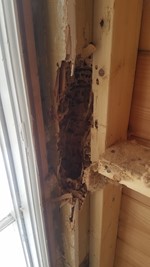
Common Renovation Setbacks
By Brian Ki, P.E.
When looking at renovations, we often get lost in the more exciting design process and the “what could be” result. The journey to the end goal, however, is often rough and very rarely goes as smooth as you might expect.
When designing on paper, it is nearly impossible to catch what is hidden behind the existing finishes. Only once demolition and construction truly begin can the building’s hidden problems start to surface. These obstacles provide a setback in construction, present additional repair costs, and almost always delays construction. Here is a quick list of common renovation setbacks:
Water Damage
Water is the worst enemy to a building. Not only does it slowly deteriorate materials, but also attracts unwanted pests, promotes mold and mildew. The liquid properties of water allow it to seep through the smallest areas and flow where it wants to go. You may have a leak at the corner of your building but find the water has found its way to the middle of the home and damaged everything in-between.
 Pests
Pests
Wood-destroying pests can do some serious damage to the bones of a building. Because it happens over long periods of time and is usually concealed by finishes, very rarely are these problems caught early. Take a look at the damaged corner in the provided photo. An entire colony of termites have completely bored this wood member and most likely have entered other areas of the home yet to be discovered.
Unsafe Materials:
The two most common outdated materials include lead and asbestos. These hazardous materials require special handling, specific disposal, and other defined laws defined by the Environmental Protection Agency (EPA) that a contractor must follow. These materials often present themselves in paint finishes, old plumbing pipes, tiles, and attic or wall insulation.
Inexperienced Construction Practices
Seen more in residential homes, cheap and inexperienced contractors often get hired for construction. Although they may have finished a past project, their lack of experience or construction knowledge sometimes leads to complications when looking to renovate the same building. Not only must the new contractor perform the current renovation, but they must first fix the original contractor’s mistakes.
New Building Code Requirements
We often get, “it’s been standing for XX amount of years, it must be safe.” The simplified logic behind that is just not true. Just because a building is standing, that does not mean it is safe. This is why the building code is continuously updated to address issues discovered year to year. When performing a renovation, design must be toward the most modernly adopted building code. This often includes elements for structures, mechanical, electrical, and plumbing systems. In rare occasions, but not unheard of, you may be replacing all of it.
So, what do you do if you encounter one or more of these problems? Contact a licensed professional to help assist and provide the next course of action. Their knowledge to their specific trait can lead to the most economical and least time-consuming solution.
More Articles From...
| This Category | Architectural Design, Condominiums, Engineered Consultations, Home Repairs, Residential Engineering, Structural Design, Structural Engineering |
| This Author | Brian Ki, P.E. |
